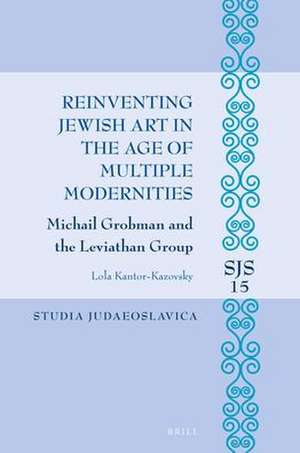Reinventing Jewish Art in the Age of Multiple Modernities: Michail Grobman and the Leviathan Group: Studia Judaeoslavica, cartea 15
Autor Lola Kantor-Kazovskyen Limba Engleză Hardback – 7 dec 2022
Preț: 805.82 lei
Preț vechi: 982.71 lei
-18% Nou
Puncte Express: 1209
Preț estimativ în valută:
154.24€ • 167.60$ • 129.65£
154.24€ • 167.60$ • 129.65£
Carte indisponibilă temporar
Doresc să fiu notificat când acest titlu va fi disponibil:
Se trimite...
Preluare comenzi: 021 569.72.76
Specificații
ISBN-13: 9789004339316
ISBN-10: 9004339310
Pagini: 305
Dimensiuni: 155 x 235 mm
Greutate: 0.61 kg
Editura: Brill
Colecția Brill
Seria Studia Judaeoslavica
ISBN-10: 9004339310
Pagini: 305
Dimensiuni: 155 x 235 mm
Greutate: 0.61 kg
Editura: Brill
Colecția Brill
Seria Studia Judaeoslavica
Notă biografică
Lola Kantor-Kazovsky holds a Ph.D. from the Hebrew University of Jerusalem, where she is currently senior lecturer in the Department of Art History. She specializes in eighteenth-century European art and modern Russian-Jewish art.
Cuprins
Preface
List of Illustrations
Introduction: Across the East-West Divide: A Portrait of the Artist in Transcultural Perspective
1 The Moscow Prelude: Visual Culture of the Cold War Era or the “Second Russian Avant-Garde”?
1 A Familiar Stranger: The Russian Encounter with Modern Art in the 1950s
2 The Impact of the American National Exhibition in Moscow: From Abstraction to Multiple Idioms
3 The “Cognitive Theory” of the Russian Avant-Garde and Its Role in the Formation of Unofficial Modern Art
4 Situating Unofficial Art Politically: Leviathan as a Symbol of Protest
2 The Notion of Modern Jewish Art across Borders
1 Jewish Art and Modern Culture: A Complex Dialogue
2 Renunciation of Art as the “Hidden Tradition” of Jewish Modernism
3 The Conflict between Traditionalist and Modernist Jewish Art
4 The Revival of Art Theory in the USSR and Grobman’s Debt to Malevich
5 The Genesis Myth and Suprematism in Grobman’s Work of the 1960s
3 Jewish vs. Israeli: Cultural Politics and Identity Controversy in the Work of the Leviathan Group
1 Shifting Self-Definitions in Local Art Scenes of the Late 1960s and Early 1970s
2 Grobman’s Jerusalem Diary: The Jewish Artist as “Other” in the Israeli Art World
3 Grobman and Conceptual Art: “Renunciation” vs. “Dematerialization of the Art Object”
4 “To Stand on the Rock of the Word ‘We’”: The Art of the Leviathan Group
4 Postmodern Variations: Too Jewish, Too Russian, Too Israeli
1 The Jewish Artist as Russian Poet and Israeli Serviceman, 1980s–1990s
2 Conclusion: Parallels, Conflicts, and Hybrids of the Patterns of Modernism in the Biography of a Single Artist
Appendices: Selected Texts by Michail Grobman
A Manifesto of Magical Symbolism
B Selected Theoretical Notes
C First Manifesto of the Leviathan Group
D Second Manifesto of the Leviathan Group
E Third Manifesto of the Leviathan Group (Part of the Leviathan Group’s Installation at the Abattoires 89 International Festival of Artistic Groups in Marseille, Which Was Dedicated to the Bicentennial of the French Revolution, Plate 68)
F The Biblical Construction of the Square
G The Riddle of Levitan
H The Second Russian Avant-Garde
Bibliography
Plates
Index
List of Illustrations
Introduction: Across the East-West Divide: A Portrait of the Artist in Transcultural Perspective
1 The Moscow Prelude: Visual Culture of the Cold War Era or the “Second Russian Avant-Garde”?
1 A Familiar Stranger: The Russian Encounter with Modern Art in the 1950s
2 The Impact of the American National Exhibition in Moscow: From Abstraction to Multiple Idioms
3 The “Cognitive Theory” of the Russian Avant-Garde and Its Role in the Formation of Unofficial Modern Art
4 Situating Unofficial Art Politically: Leviathan as a Symbol of Protest
2 The Notion of Modern Jewish Art across Borders
1 Jewish Art and Modern Culture: A Complex Dialogue
2 Renunciation of Art as the “Hidden Tradition” of Jewish Modernism
3 The Conflict between Traditionalist and Modernist Jewish Art
4 The Revival of Art Theory in the USSR and Grobman’s Debt to Malevich
5 The Genesis Myth and Suprematism in Grobman’s Work of the 1960s
3 Jewish vs. Israeli: Cultural Politics and Identity Controversy in the Work of the Leviathan Group
1 Shifting Self-Definitions in Local Art Scenes of the Late 1960s and Early 1970s
2 Grobman’s Jerusalem Diary: The Jewish Artist as “Other” in the Israeli Art World
3 Grobman and Conceptual Art: “Renunciation” vs. “Dematerialization of the Art Object”
4 “To Stand on the Rock of the Word ‘We’”: The Art of the Leviathan Group
4 Postmodern Variations: Too Jewish, Too Russian, Too Israeli
1 The Jewish Artist as Russian Poet and Israeli Serviceman, 1980s–1990s
2 Conclusion: Parallels, Conflicts, and Hybrids of the Patterns of Modernism in the Biography of a Single Artist
Appendices: Selected Texts by Michail Grobman
A Manifesto of Magical Symbolism
B Selected Theoretical Notes
C First Manifesto of the Leviathan Group
D Second Manifesto of the Leviathan Group
E Third Manifesto of the Leviathan Group (Part of the Leviathan Group’s Installation at the Abattoires 89 International Festival of Artistic Groups in Marseille, Which Was Dedicated to the Bicentennial of the French Revolution, Plate 68)
F The Biblical Construction of the Square
G The Riddle of Levitan
H The Second Russian Avant-Garde
Bibliography
Plates
Index











